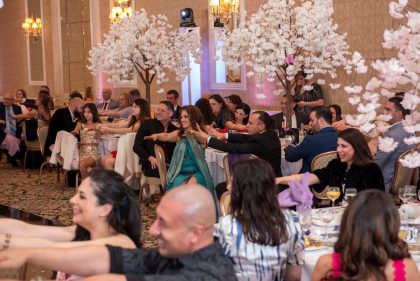
Daniela Ivanova-Nyberg in Bulgarian folk costume. Source: FB profile of the author
.
Presented at The International Joint Conference of Nordic Forum for Dance Research (NOFOD) and Society of Dance History Scholars (SDHS). Norwegian University of Science and Technology, Trondheim, Norway, June 8-11, 2013. In: Ken Pierce (editor), Dance ACTions — Traditions and Transformations, Proceedings for The 36th SDHS Annual Conference 2013: 171-179. Society of Dance History Scholars Publication
.
Choreographer as a Culture Hero?
Daniela Ivanova-Nyberg
Abstract
This paper discusses the role of the Bulgarian folk dance choreographer in creation and dissemination of cultural knowledge. The overview of the period 1944-1989 (with the foundation and development of folk choreography institutions and folk dance ensemble activities) is followed by remarks regarding the folk dance activities in the post-socialist era. Attention is drawn to teaching methodology and the general impact of professional choreography training on both stage ensemble and recreational folk dance activities. As either an ensemble leader or recreational folk dance instructor the choreographer became the figure responsible for introduction of traditional dances (old “texts”) and choreographies based on folklore. These became new texts for cultural memorization.
Introduction
In order to underline the importance of the choreographer’s work I have adopted the concept “culture hero,” used here metaphorically and even poetically.1 By providing a personal note at the beginning, I intend to more precisely clarify what I mean by this title, where I stand in my research, and what my thesis and perspectives are.
About thirty years ago, when I was a Bulgarian Folk Choreography student at the Institute for Music and Choreography in Sofia, I was introduced to a book entitled “Ballet τver the Centuries,” written by Bulgarian ballet specialist Ana Alexandrova. This book included a quotation from the second century A.D. writer, Λουκιανός Σαμοσάτων [Lucian of Samosata], related to dance. In Bulgarian the term ορχήσις [orchēsis], used by Λουκιαν, was translated as dance-chain leader [“vodach na horovoda”], (Alexandrova 1983: 24). In English, as I discovered later, it was translated as “pantomime” (a dance or pantomime performer, associated later with the ballet-dancer). Lucian states:
You will find that his is no easy profession, nor lightly to be undertaken; requiring as it does, the highest standard of culture in all its branches, and involving a knowledge not of music only, but of rhythm and metre…
One who creates steps and figures, according to Lucian, must have universal knowledge: must know geometry in order to construct figures, philosophy and rhetoric in order to depict characters and to arouse passions, the art of painting and of sculpture in order to compose groups and ensembles. As far as mythology is concerned, he/she is obliged to know perfectly well the events from antiquity to the present days.
I won’t go as far as claiming that this description set the standard that I have faithfully pursued in my own choreographic work. It stood up, however, as a strong reminder that a dance-creating person is indeed a world-creating one. This is especially true when one works on a grand scale by involving many people and consequently, steadily disseminates Presented at The International Joint Conference of Nordic Forum for Dance Research (NOFOD) and Society of Dance History Scholars (SDHS). Norwegian University of Science and Technology, Trondheim, Norway, June 8-11, 2013. In: Ken Pierce (editor), Dance ACTions — Traditions and Transformations, Proceedings for The 36th SDHS Annual Conference 2013: 171-179. Society of Dance History Scholars Publication. one’s own knowledge and interpretation of the past, with one’s ideas, sense of beauty and proportion, dance mastery, style and more. Every choreographer, as we named this profession centuries later (and I will skip the history of the term), is responsible for transmitting specific cultural messages; he/she is, in a sense, a culture hero.
We may recall many philosophers and thinkers from antiquity to the present who discuss the influence of music one listens to in one’s youth, paintings which surround us, books one reads, and arts in general (from the 20th century philosophers Susan Langer comes to mind right away). To this series I will add later, with a bit of underlining, “the dances we grew up with.”
Returning to my example, Lucian’s thoughts caught my realization that knowledge of steps, figures and choreographic principles is only the first step of a long journey, one which I was already eager to undertake. Another realization of my twenties was that, due to the 1950s and later Bulgarian urbanization, learning traditional Bulgarian dances in their traditional contexts was not part of the 1980s reality. If a city child wanted to learn folk dance his parents would send the child to one of the city’s folk dance ensembles. Here the child met the choreographer, was introduced to the Bulgarian character exercise (adopted from the Soviet Union ensemble model, although with Bulgarian character elements), and learned the repertoire. As a result, a child with several years of dance ensemble experience would have in its body and mind dozens and dozens of dance combinations but would not be able to name or dance more than a few traditional dances. These early realizations coalesced and sent me on the path toward my future studies and professional work.
In my paper I want to discuss the impact of the folk professional training along with showing a few 2013 video examples that I find illustrative. One of them is a YouTube recording of a men’s dance during a Bulgarian wedding. This post probably broke all records of visiting somebody’s’ private wedding, ever. I will also share some examples from this years’ large Bulgarian Festival in Chicago.
The possibility to conduct fieldwork in the States since 2003 now provides ground for comparative studies of Bulgarian dance both inside and outside the homeland and offers a whole new array of research opportunities. But before introducing my examples let me first provide few brief contextual notes.
Full scientific report here:
Choreographer_as_a_Culture_Hero_Bulgaria
.


